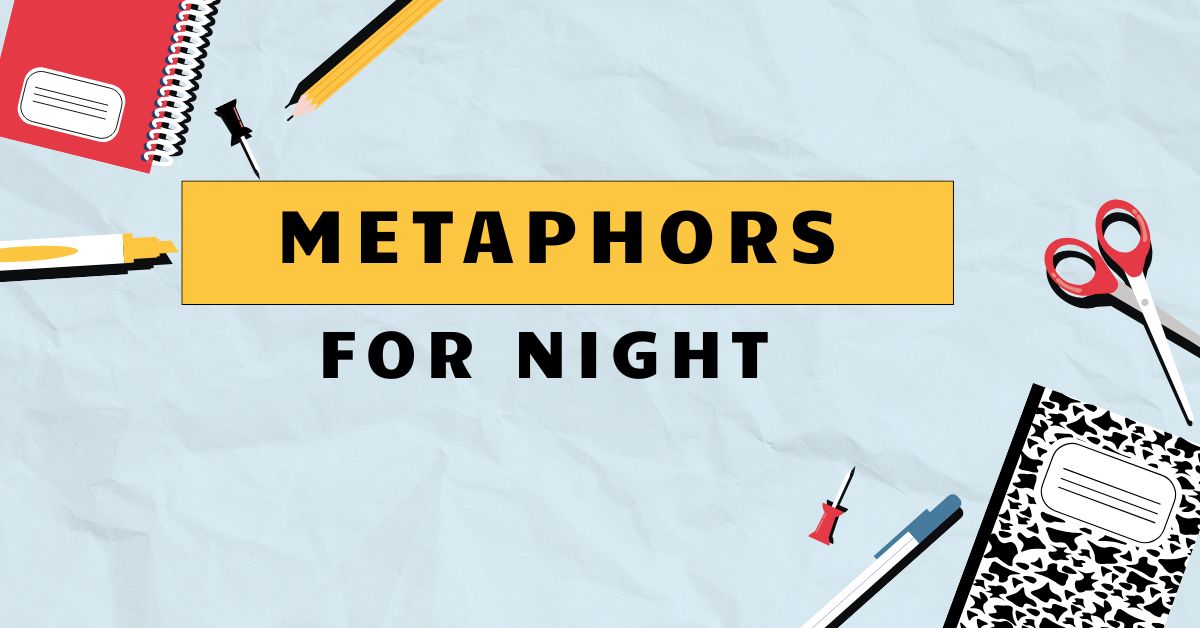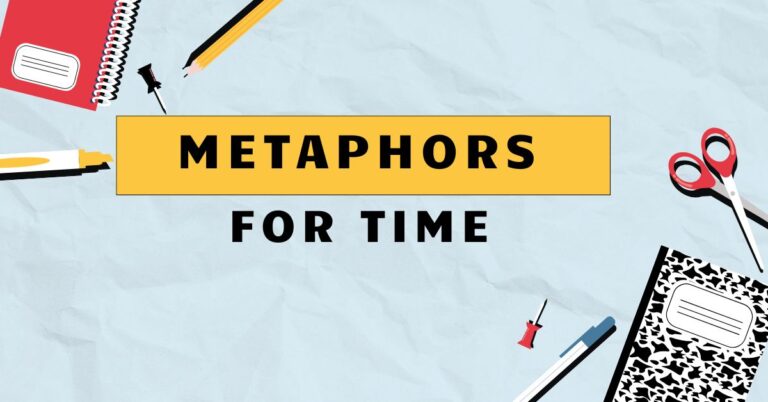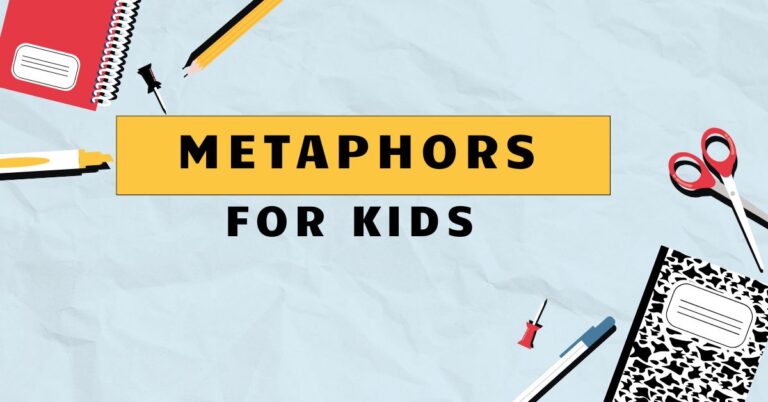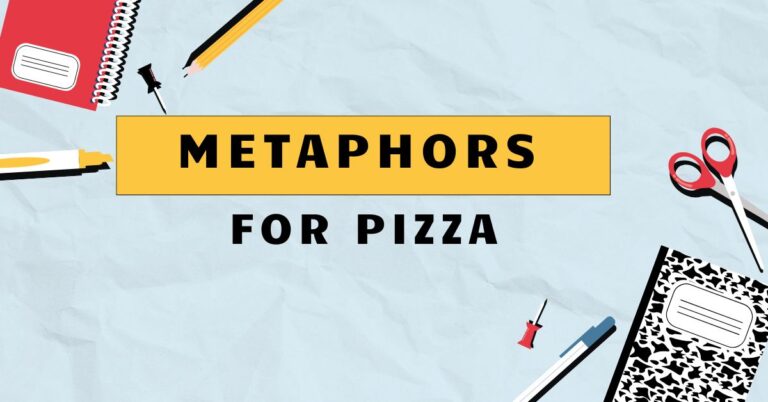43 Metaphors for Night: Understanding Figurative Language
Metaphors are powerful tools in the English language, allowing us to paint vivid pictures and convey complex ideas in a concise and imaginative way. Understanding metaphors, especially those used to describe the night, enhances our comprehension of literature, poetry, and everyday speech.
This article delves into the various metaphors used for “night,” exploring their meanings, structures, and applications. Whether you’re a student, a writer, or simply someone interested in expanding your linguistic horizons, this guide will provide you with a comprehensive understanding of this fascinating aspect of figurative language.
Table of Contents
- Introduction
- Definition of Metaphor and Night
- Structural Breakdown of Night Metaphors
- Types of Night Metaphors
- Examples of Night Metaphors
- Usage Rules for Night Metaphors
- Common Mistakes with Night Metaphors
- Practice Exercises
- Advanced Topics in Night Metaphors
- Frequently Asked Questions
- Conclusion
Definition of Metaphor and Night
Ametaphoris a figure of speech that directly compares two unlike things without using “like” or “as.” It asserts that one thingisanother, attributing qualities of the second thing to the first. This comparison is not literal but rather imaginative, creating a new understanding of the subject.
Metaphors enrich language by adding layers of meaning and emotional resonance.
Night, in its most literal sense, refers to the period of darkness between sunset and sunrise. However, metaphorically, night can represent various concepts such as: the end of something, a time of rest, a period of uncertainty or fear, or even a time of mystery and beauty.
The specific meaning depends on the context and the qualities attributed to it in the metaphor.
Structural Breakdown of Night Metaphors
Understanding the structure of metaphors helps in both interpreting and creating them effectively. A metaphor typically consists of two main elements: thetenorand thevehicle.
The tenor is the subject being described (in this case, night), and the vehicle is the object or concept used to describe it. The vehicle lends its qualities to the tenor, creating a new understanding.
For example, in the metaphor “Night is a velvet curtain,” the tenor is “night,” and the vehicle is “velvet curtain.” The qualities of a velvet curtain—softness, darkness, and the ability to conceal—are attributed to the night, suggesting a night that is gentle and enveloping.
The effectiveness of a metaphor depends on the relationship between the tenor and the vehicle. A strong metaphor creates a clear and evocative connection, while a weak metaphor may be confusing or ineffective.
Types of Night Metaphors
Metaphors for night can be categorized based on the types of qualities or characteristics they attribute to night. Here are some common categories:
Night as a Person
This type of metaphor personifies night, giving it human qualities such as emotions, actions, or physical attributes. This can create a sense of intimacy or drama, allowing the reader to connect with the night on a personal level.
Night as a Creature
Here, night is compared to an animal or mythical creature. This can evoke feelings of fear, mystery, or even beauty, depending on the specific creature used.
The metaphor might focus on the creature’s movements, sounds, or appearance.
Night as a Covering
This category uses metaphors that describe night as something that covers or envelops the world. This emphasizes the darkness and all-encompassing nature of night, creating a sense of security or oppression, depending on the context.
Night as a Place
Night can be metaphorically treated as a location, a space where things happen or where one can find certain experiences. This might emphasize the atmosphere, the inhabitants, or the potential for adventure or danger.
Night as a Time
This type of metaphor focuses on the temporal aspect of night, often associating it with specific events, feelings, or transitions. It can highlight the cyclical nature of time or the unique qualities of the night period.
Examples of Night Metaphors
The following tables provide numerous examples of metaphors for night, categorized by the types discussed above. Each example is intended to illustrate the specific qualities and effects of each type.
Table 1: Night as a Person
This table illustrates metaphors where night is personified, imbued with human-like qualities and actions. Notice how the verbs and adjectives used evoke different emotions and imagery.
| Metaphor | Explanation |
|---|---|
| Night is a weary traveler, finally resting. | Night is depicted as tired and seeking rest, suggesting peace and tranquility. |
| Night is a silent guardian, watching over the sleeping world. | Night is portrayed as protective and vigilant, offering a sense of security. |
| Night is a mischievous imp, playing tricks with shadows. | Night is seen as playful and unpredictable, creating an atmosphere of mystery. |
| Night is a grieving widow, cloaked in sorrow. | Night is associated with sadness and mourning, evoking a feeling of melancholy. |
| Night is a storyteller, whispering secrets to the stars. | Night is depicted as sharing knowledge and mysteries, adding a sense of wonder. |
| Night is a painter, coloring the world in shades of gray. | Night is portrayed as creative and artistic, transforming the landscape. |
| Night is a dancer, twirling with the wind. | Night is depicted as graceful and dynamic, creating a sense of movement. |
| Night is a judge, delivering verdicts of dreams and nightmares. | Night is seen as authoritative and decisive, influencing our subconscious. |
| Night is a doctor, healing the wounds of the day. | Night is portrayed as restorative and comforting, offering relief and renewal. |
| Night is a beggar, seeking light from the moon. | Night is depicted as needy and dependent, emphasizing its reliance on external sources. |
| Night is a thief, stealing the colors of the day. | Night is portrayed as deceptive and depriving, highlighting the loss of daylight. |
| Night is a queen, ruling over a kingdom of darkness. | Night is seen as powerful and dominant, controlling the nocturnal realm. |
| Night is a jester, mocking the seriousness of day. | Night is depicted as humorous and irreverent, challenging the norms of daylight. |
| Night is a philosopher, pondering the mysteries of the universe. | Night is portrayed as thoughtful and contemplative, encouraging introspection. |
| Night is a lover, embracing the world in its arms. | Night is seen as affectionate and encompassing, offering comfort and solace. |
| Night is a teacher, instructing us in the language of dreams. | Night is depicted as educational and enlightening, guiding us through our subconscious. |
| Night is a singer, serenading us with the crickets’ song. | Night is portrayed as musical and soothing, creating a relaxing atmosphere. |
| Night is a soldier, guarding us from hidden dangers. | Night is seen as protective and vigilant, ensuring our safety during darkness. |
| Night is a poet, crafting verses of shadows and moonlight. | Night is depicted as creative and artistic, inspiring beautiful and evocative imagery. |
| Night is a dancer, leading the stars in a celestial waltz. | Night is portrayed as graceful and dynamic, orchestrating the movements of the cosmos. |
Table 2: Night as a Creature
This table contains examples where night is likened to various creatures, each bringing its own set of associations and symbolic meanings. Consider how the chosen creature influences the overall tone and imagery.
| Metaphor | Explanation |
|---|---|
| Night is a black cat, silently stalking its prey. | Night is mysterious and predatory, suggesting hidden dangers. |
| Night is an owl, watching with wise and knowing eyes. | Night is observant and knowledgeable, offering a sense of guidance. |
| Night is a bat, flitting through the darkness. | Night is elusive and quick, creating an atmosphere of mystery. |
| Night is a wolf, howling at the moon. | Night is wild and untamed, evoking feelings of fear and loneliness. |
| Night is a spider, weaving its web of dreams. | Night is intricate and captivating, drawing us into the world of sleep. |
| Night is a serpent, slithering through the trees. | Night is sneaky and dangerous, creating a sense of unease and foreboding. |
| Night is a moth, drawn to the flickering flame. | Night is attracted to light, despite potential danger, symbolizing vulnerability. |
| Night is a hawk, circling high above the world. | Night is observant and powerful, overseeing everything with a broad perspective. |
| Night is a fox, cunningly navigating the shadows. | Night is clever and resourceful, finding its way through challenges. |
| Night is a raven, croaking ominous warnings. | Night is foreboding and prophetic, signaling potential dangers or changes. |
| Night is a firefly, blinking its light in the darkness. | Night is a source of hope and guidance, shining through the gloom. |
| Night is a jellyfish, floating in the deep sea of sleep. | Night is a surreal and dreamlike experience, drifting through the subconscious. |
| Night is a chameleon, blending into the surrounding darkness. | Night is adaptable and elusive, changing its appearance to suit the environment. |
| Night is a dragonfly, shimmering with iridescent wings. | Night is beautiful and ethereal, adding a touch of magic to the world. |
| Night is a scorpion, hiding beneath the rocks. | Night is dangerous and unpredictable, posing a threat to the unwary. |
| Night is a peacock, displaying its starry plumage. | Night is extravagant and magnificent, showcasing the beauty of the cosmos. |
| Night is a turtle, slowly retreating into its shell. | Night is a time of withdrawal and introspection, seeking safety and solitude. |
| Night is a luna moth, gracefully fluttering in the moonlight. | Night is enchanting and delicate, adding a touch of ethereal beauty. |
| Night is a gremlin, causing mischief and mayhem. | Night is playful and disruptive, leading to unexpected events. |
| Night is a sphinx, guarding ancient secrets. | Night is mysterious and enigmatic, holding knowledge that is difficult to access. |
Table 3: Night as a Covering
This table presents metaphors that depict night as a covering or blanket, emphasizing its all-encompassing nature. Note how the texture and weight of the covering influence the overall feeling.
| Metaphor | Explanation |
|---|---|
| Night is a velvet blanket, soft and comforting. | Night is gentle and soothing, providing a sense of security. |
| Night is a heavy cloak, weighing down the world. | Night is oppressive and burdensome, creating a feeling of unease. |
| Night is a dark shroud, concealing all secrets. | Night is mysterious and secretive, hiding things from view. |
| Night is a starry canopy, glittering with diamonds. | Night is beautiful and expansive, inspiring awe and wonder. |
| Night is a smoky veil, blurring the edges of reality. | Night is hazy and indistinct, making it difficult to see clearly. |
| Night is a thick fog, disorienting and confusing. | Night is obscuring and unsettling, making navigation difficult. |
| Night is a silken sheet, smooth and cool. | Night is luxurious and refreshing, providing a sense of calm. |
| Night is a tattered curtain, revealing glimpses of light. | Night is imperfect and fragile, hinting at the return of day. |
| Night is a woolen shawl, warm and protective. | Night is comforting and sheltering, providing a sense of security. |
| Night is a canvas, painted with stars and shadows. | Night is artistic and imaginative, creating a beautiful and evocative scene. |
| Night is a lid, sealing the world in slumber. | Night is enclosing and protective, ensuring a period of rest and rejuvenation. |
| Night is a dome, encompassing the earth in darkness. | Night is all-encompassing and vast, creating a sense of enclosure and intimacy. |
| Night is a net, catching dreams and fantasies. | Night is a collector of subconscious thoughts, capturing the essence of our dreams. |
| Night is a tent, providing shelter from the elements. | Night is a safe haven, offering protection and security from the outside world. |
| Night is a mask, concealing true identities. | Night is a cover for hidden intentions, allowing for anonymity and disguise. |
| Night is a sail, carrying us to the shores of sleep. | Night is a vehicle for transporting us to a state of rest and relaxation. |
| Night is a shroud, enveloping the world in silence. | Night is a blanket of quiet, muffling sounds and creating a sense of stillness. |
| Night is a tapestry, woven with stars and moonlight. | Night is intricate and beautiful, a work of art created by the cosmos. |
| Night is a shadow, lurking behind every corner. | Night is a presence that follows us, creating a sense of mystery and unease. |
| Night is a veil, partially obscuring our vision. | Night is a barrier to clear sight, limiting our ability to perceive the world around us. |
Table 4: Night as a Place
This table presents metaphors that characterize night as a location, emphasizing its unique atmosphere and potential experiences. Consider the specific qualities of each location and how they relate to the night.
| Metaphor | Explanation |
|---|---|
| Night is a silent city, where dreams roam free. | Night is a place of imagination and subconscious activity. |
| Night is a dark forest, full of hidden dangers. | Night is mysterious and threatening, evoking feelings of fear. |
| Night is a starry ocean, vast and unexplored. | Night is expansive and unknown, inviting exploration and discovery. |
| Night is a quiet sanctuary, offering peace and solitude. | Night is a place of refuge and tranquility, providing a sense of calm. |
| Night is a secret garden, blooming with nocturnal wonders. | Night is enchanting and beautiful, revealing hidden delights. |
| Night is a haunted house, filled with ghostly whispers. | Night is eerie and unsettling, evoking feelings of dread and suspense. |
| Night is a cosmic theater, staging celestial dramas. | Night is a spectacle of cosmic events, offering a grand and awe-inspiring show. |
| Night is a hidden cave, sheltering ancient secrets. | Night is a repository of forgotten knowledge, holding mysteries from the past. |
| Night is a dreamscape, where reality bends and twists. | Night is a surreal and imaginative realm, where the rules of reality do not apply. |
| Night is a star-studded ballroom, where planets dance. | Night is a vibrant and dynamic space, filled with celestial movement and energy. |
| Night is a shadowy alley, where secrets are traded. | Night is a clandestine space, where hidden activities take place. |
| Night is a moonlit beach, where waves whisper stories. | Night is a romantic and peaceful setting, filled with the sounds of nature. |
| Night is a celestial library, filled with stories of the stars. | Night is a collection of cosmic narratives, offering endless tales of the universe. |
| Night is a quiet meadow, where fireflies twinkle. | Night is a serene and magical place, filled with the gentle light of fireflies. |
| Night is a darkened stage, waiting for the dawn. | Night is a pause before a new beginning, anticipating the arrival of daylight. |
| Night is a cosmic playground, where stars play hide-and-seek. | Night is a playful and imaginative space, filled with the wonders of the universe. |
| Night is a silent monastery, where souls find solace. | Night is a place of peace and reflection, providing comfort and spiritual renewal. |
| Night is a starlit desert, vast and empty. | Night is a lonely and expansive space, filled with the beauty of the stars. |
| Night is a hidden portal, leading to other worlds. | Night is a gateway to the unknown, offering the possibility of adventure and exploration. |
| Night is a celestial observatory, where we study the universe. | Night is a place for learning and discovery, allowing us to understand the cosmos. |
Table 5: Night as a Time
This table illustrates metaphors where night is treated as a specific time, often associated with particular events or feelings. Consider the temporal qualities and how they relate to the night.
| Metaphor | Explanation |
|---|---|
| Night is the end of the day’s journey. | Night represents the conclusion of daily activities and responsibilities. |
| Night is the pause before a new beginning. | Night is a period of rest and preparation for the next day. |
| Night is the time for dreams and fantasies. | Night is associated with the subconscious and imaginative thoughts. |
| Night is the hour of secrets and mysteries. | Night is a time when things are hidden or unexplained. |
| Night is the moment for reflection and introspection. | Night is a time for thinking deeply about one’s thoughts and feelings. |
| Night is the season of rest and rejuvenation. | Night is a period of physical and mental recovery. |
| Night is the age of darkness and uncertainty. | Night represents a period of difficulty and unknown challenges. |
| Night is the prelude to a brighter tomorrow. | Night is a time that leads to hope and optimism. |
| Night is the interval between acts in life’s play. | Night is a break or transition between important events. |
| Night is the era of shadows and whispers. | Night is associated with quiet and hidden communications. |
| Night is the span for healing and renewal. | Night is dedicated to physical and emotional recovery. |
| Night is the phase of quiet contemplation. | Night is a time for peaceful and thoughtful consideration. |
| Night is the interlude of starlight and moonlight. | Night is a period illuminated by celestial bodies. |
| Night is the epoch when imagination thrives. | Night fosters creativity and fanciful thought. |
| Night is the window for viewing the cosmos. | Night affords the opportunity to observe the universe. |
| Night is the chapter of stillness and peace. | Night offers a respite from daytime activity. |
| Night is the period for dreams to take flight. | Night is conducive to vivid and fantastical dreams. |
| Night is the space when fears come out to play. | Night can amplify anxieties and insecurities. |
| Night is the segment for stars to shine brightest. | Night provides the optimal conditions for stargazing. |
| Night is the duration of magic and mystery. | Night is filled with enchanting and unexplained phenomena. |
Usage Rules for Night Metaphors
Using metaphors effectively requires careful consideration of context, audience, and purpose. Here are some general rules to follow:
- Clarity: Ensure that the connection between the tenor and the vehicle is clear and understandable. Avoid metaphors that are too obscure or confusing.
- Relevance: Choose metaphors that are relevant to the overall theme or message of your writing. The metaphor should enhance the meaning, not distract from it.
- Originality: Strive for fresh and original metaphors. Overused metaphors can become clichés and lose their impact.
- Consistency: Maintain consistency in your use of metaphors. Avoid mixing metaphors that create conflicting images or ideas.
- Appropriateness: Consider the tone and style of your writing. Choose metaphors that are appropriate for the audience and the subject matter.
Common Mistakes with Night Metaphors
Even experienced writers can make mistakes when using metaphors. Here are some common pitfalls to avoid:
- Mixed Metaphors: Combining two or more metaphors that create a contradictory or nonsensical image.
- Incorrect: “The night was a velvet blanket sailing through a sea of stars.” (Mixing a blanket with sailing creates a confusing image.)
- Correct: “The night was a velvet blanket, soft and comforting.”
- Clichés: Using overused or predictable metaphors that have lost their impact.
- Cliché: “Night was as black as coal.”
- Improved: “Night was a canvas of deep indigo, speckled with diamond dust.”
- Inappropriate Metaphors: Using metaphors that are not suitable for the context or audience.
- Inappropriate: “Night was a garbage dump.” (Unless the context specifically warrants such a negative comparison.)
- Improved: “Night was a quiet refuge from the day’s chaos.”
- Overextended Metaphors: Continuing a metaphor for too long, to the point where it becomes strained or ridiculous.
Practice Exercises
Test your understanding of night metaphors with these exercises. Identify the type of metaphor used in each sentence and explain its meaning.
Exercise 1: Identify the Type of Metaphor
Determine whether each of the following metaphors depicts night as a person, creature, covering, place, or time.
| Question | Answer |
|---|---|
| 1. Night is a dark ocean, full of mysterious creatures. | Place |
| 2. Night is a heavy cloak, smothering the world in darkness. | Covering |
| 3. Night is a sly fox, creeping through the shadows. | Creature |
| 4. Night is a weary traveler, seeking rest after a long day. | Person |
| 5. Night is the hour when dreams come alive. | Time |
| 6. Night is a silent guardian, watching over the sleeping city. | Person |
| 7. Night is a star-studded canvas, painted with cosmic wonders. | Covering |
| 8. Night is a haunted forest, filled with eerie sounds. | Place |
| 9. Night is a black cat, silently stalking its prey. | Creature |
| 10. Night is the end of all things. | Time |
Exercise 2: Complete the Metaphor
Fill in the blanks to complete the following metaphors for night.
| Question | Answer |
|---|---|
| 1. Night is a ______ blanket, offering warmth and comfort. | velvet |
| 2. Night is a dark ______, concealing all secrets. | shroud |
| 3. Night is a silent ______, where dreams roam free. | city |
| 4. Night is a ______ owl, watching with wise eyes. | solitary |
| 5. Night is the ______ of reflection and introspection. | time |
| 6. Night is a cosmic ______, full of unexplored wonders. | ocean |
| 7. Night is a sly ______, creeping through the shadows. | fox |
| 8. Night is a ______ storyteller, whispering secrets to the stars. | silent |
| 9. Night is the ______ before a new beginning. | pause |
| 10. Night is a starry ______, glittering with celestial diamonds. | canopy |
Exercise 3: Create Your Own Metaphor
Write five original metaphors for night, using each of the categories discussed in this article (person, creature, covering, place, time).
(Answers will vary, but should demonstrate understanding of each metaphor type.)
Advanced Topics in Night Metaphors
For advanced learners, exploring the use of extended metaphors and symbolism can further enhance their understanding and application of night metaphors. Anextended metaphoris a metaphor that is developed over several lines or even an entire work, allowing for a more complex and nuanced comparison.Symbolisminvolves using objects, people, or events to represent abstract ideas or concepts, adding layers of meaning to the metaphor.
For example, night might symbolize death, the unknown, or a period of spiritual darkness.
Analyzing literary works for their use of night metaphors can provide valuable insights into the author’s themes and intentions. The choice of specific metaphors and their development throughout the text can reveal deeper meanings and enhance the reader’s understanding of the work.
Frequently Asked Questions
- What is the difference between a metaphor and a simile?
A metaphor directly equates two unlike things, while a simile uses “like” or “as” to make a comparison. For example, “Night is a black cat” (metaphor) versus “Night is like a black cat” (simile).
- Why are metaphors important in writing?
Metaphors add depth, imagery, and emotional resonance to writing. They help to convey complex ideas in a concise and memorable way, making the writing more engaging and impactful.
- How can I create more original metaphors?
To create original metaphors, try to think beyond the obvious. Consider unusual or unexpected connections between the tenor and the vehicle. Experiment with different perspectives and sensory details to create a unique image.
- What is a mixed metaphor, and why should I avoid it?
A mixed metaphor combines two or more metaphors that create a contradictory or nonsensical image. It should be avoided because it can confuse the reader and weaken the impact of the writing.
- How do I know if a metaphor is appropriate for my audience?
Consider the age, background, and knowledge level of your audience. Choose metaphors that are relevant and understandable to them. Avoid metaphors that are too obscure, technical, or culturally specific.
- Can a metaphor be too complex?
Yes, a metaphor can be too complex if it is difficult to understand or if it distracts from the main point of the writing. Aim for clarity and relevance in your metaphors.
- How can I analyze metaphors in literature?
To analyze metaphors in literature, identify the tenor and the vehicle, and consider the qualities that are being attributed to the tenor. Think about the overall effect of the metaphor and how it contributes to the themes and meanings of the work.
- What is the role of symbolism in metaphors?
Symbolism adds layers of meaning to metaphors by using objects, people, or events to represent abstract ideas or concepts. This can enhance the depth and complexity of the metaphor.
- Is it possible to overuse metaphors?
Yes, it’s possible to overuse metaphors. When metaphors are too frequent, they can become distracting and lose their impact. Use them judiciously and purposefully.
- How do cultural differences affect the interpretation of metaphors?
Cultural differences can significantly impact the interpretation of metaphors. Certain images or concepts may have different meanings or associations in different cultures, leading to misunderstandings or misinterpretations. It’s important to be aware of these cultural nuances when using metaphors in cross-cultural communication.
Conclusion
Mastering the art of using metaphors for “night” allows for richer, more evocative communication. By understanding the different types of metaphors—personification, creature comparisons, coverings, places, and times—you can craft vivid and impactful descriptions.
Remember to focus on clarity, originality, and appropriateness to ensure your metaphors resonate with your audience. Avoid common pitfalls such as mixed metaphors and clichés to maintain the strength of your writing.
Keep practicing and analyzing metaphors in various contexts to further develop your skills and deepen your appreciation for the power of figurative language. With careful consideration and creative exploration, you can illuminate the darkness with the beauty of metaphor.







